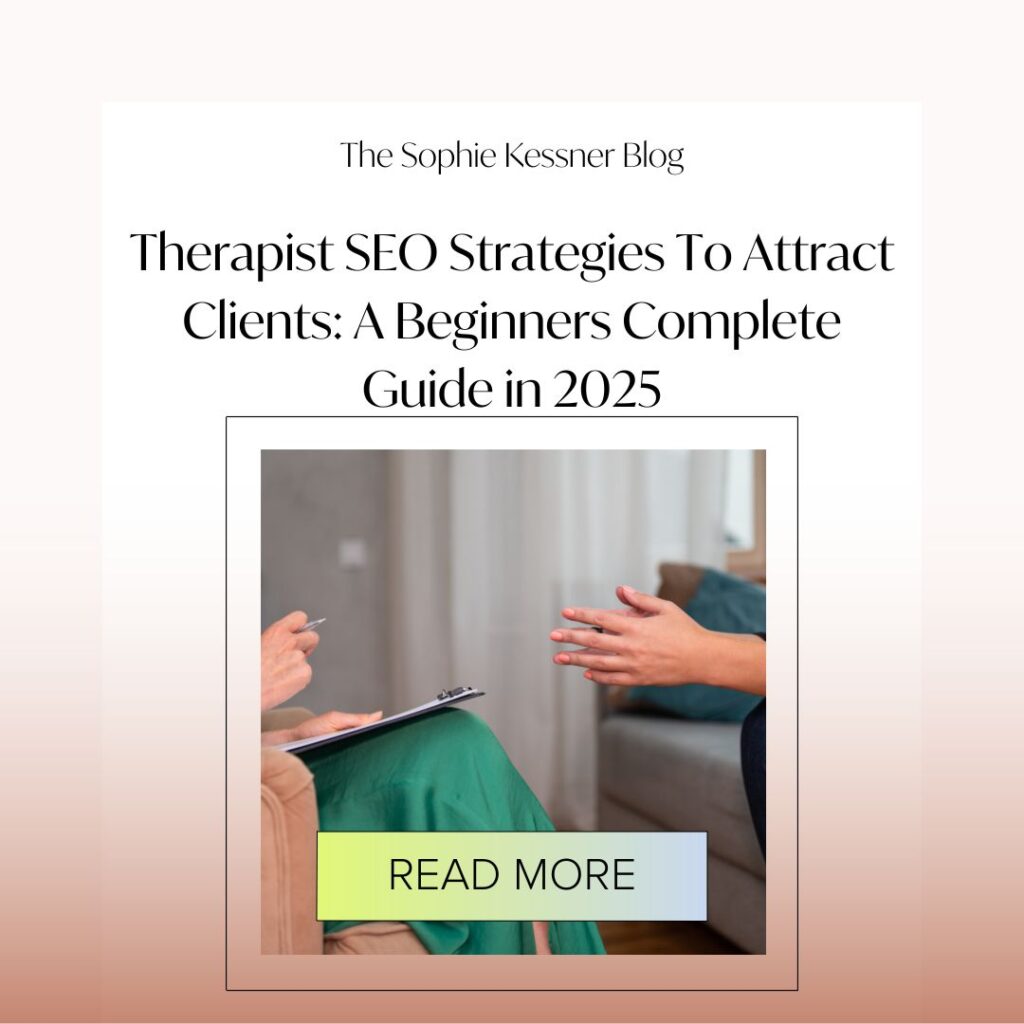SEO is a game-changer when it comes to getting your therapy practice noticed online. With search engines constantly updating their algorithms, it’s important to stay on top of the latest strategies to keep your website ranking high and attracting potential clients.
In this guide, we’ll break down key SEO strategies for therapists in a simple, practical way. You’ll learn how to find the right keywords, create engaging content that naturally includes them, and optimize title tags and meta descriptions for better visibility. We’ll also cover link-building techniques, including outreach efforts and therapist directories, to help boost your website’s credibility.
Beyond content, we’ll dive into improving your site’s performance using tools like GTMetrix and increasing site speed. Plus, we’ll explore the power of citations and how to optimize your Google Business listing to strengthen your online presence. Let’s get started on making SEO work for you!
Search Engine Optimization Simplified
Search Engine Optimization (SEO) is a simple and effective way to maximize content marketing for your private practice.
Though SEO may sound scary and technical, we will show you how SEO for therapists can be a smooth and simple process to get found by your ideal clients.
How Do Search Engines Work?
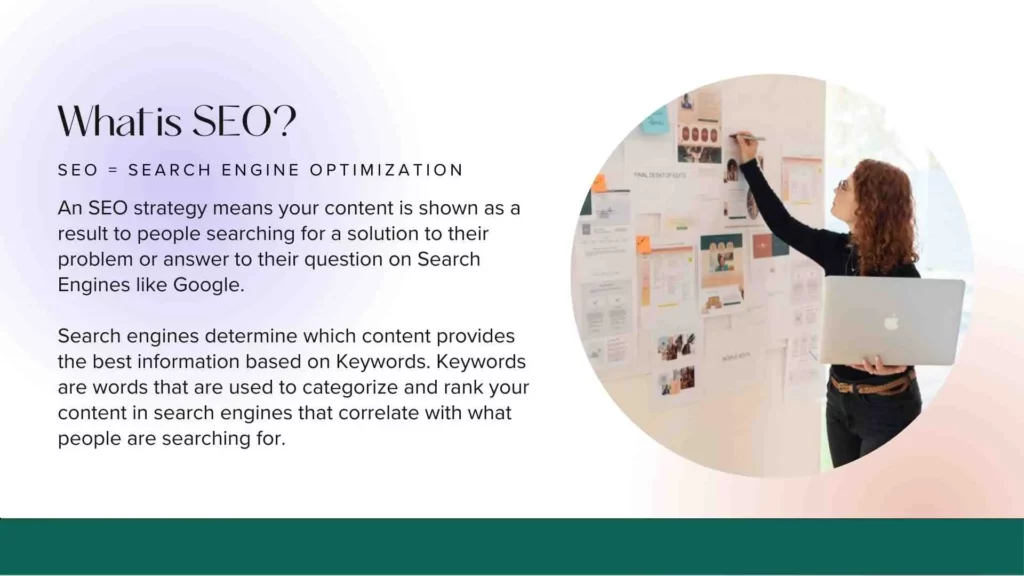
Have you ever heard of the term Google it? This refers to the exact process of Search engines you use daily.
Whenever a person searches for answers to their questions types that question into a platform like Google or YouTube, you’re presented with the Search Engine Results Page, also known as the SERP, where Google Suggests the most relevant sites that answer their question based on the search terms used to ask the question.
Then the person searching will click on each page until they find what they are looking for and end the search.
This is also known as “ending the search query” and is the whole goal of Search Engine Optimization for any piece of website content.
By incorporating Specific Keywords on any therapy website or web pages, you’ll help search engines recognize the quality content you have and better index your content for Google search results, allowing you to generate free organic traffic to any private practice website.
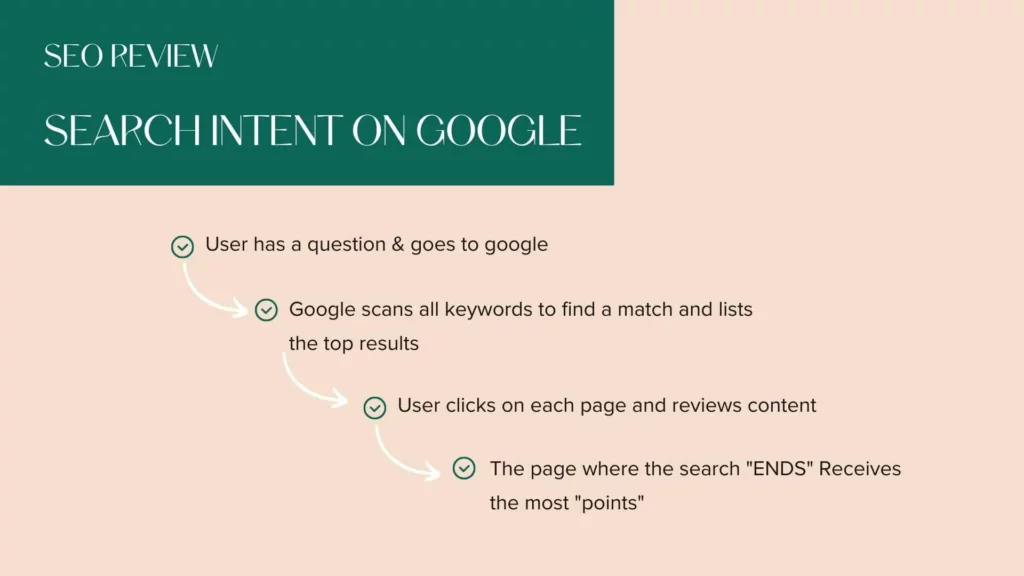
Understanding Keywords for Therapists
Keywords are crucial for therapists to rank higher on search engines.
Targeting specific long-tail keywords related to your services and audience needs can help you reach potential clients searching for therapy or counseling online.
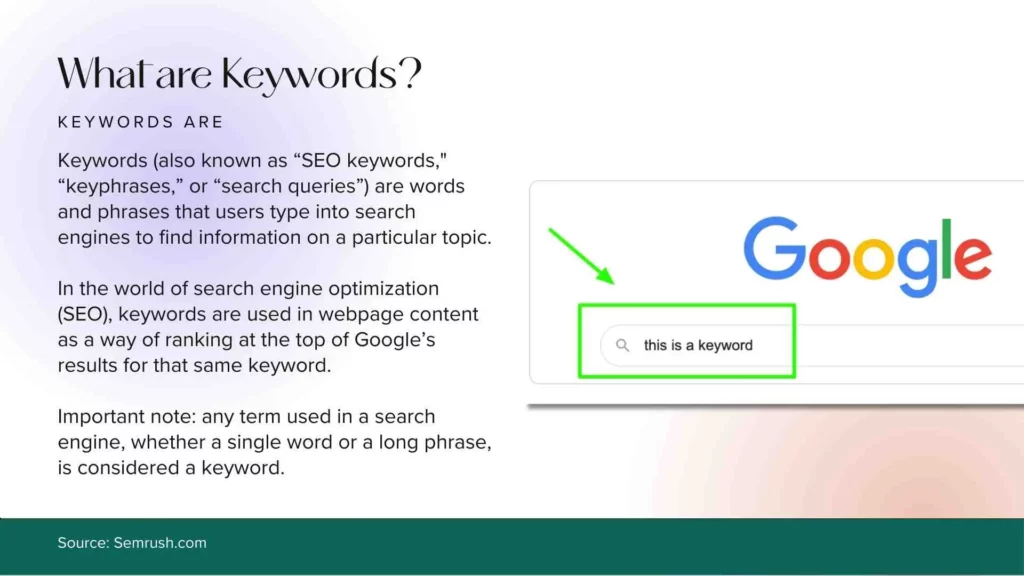
Importance of Long-Tail Keywords in SEO for Therapists
Long-tail keywords are more specific and have higher conversion rates.
For therapists, targeting these phrases can lead to better visibility on Search Engine Results Page (SERPs) and attract users who are actively seeking the services you offer.
For example, “couples therapy near me” is more targeted than “therapy” and has less competition from other websites trying to rank for the same term.
Understanding Search Intent
Search intent refers to the reason behind a user’s search query. Understanding this intent helps ensure your content aligns with what potential clients are looking for. There are three main types:
-
Informational Intent – Users looking for general knowledge, such as “benefits of therapy” or “how does EMDR work.”
-
Navigational Intent – Users searching for a specific practice, like “best therapy clinics near me.”
-
Transactional Intent – Users ready to take action, such as “trauma therapist in San Diego” or “book anxiety therapy session.”
By structuring your content around search intent, you can improve user engagement, increase website traffic, and convert more visitors into clients.
Categorizing Keywords for Therapists
To effectively optimize your website, it helps to categorize keywords based on competition level and local relevance. Here are three main types:
-
Local Keywords – These target clients searching for therapy services in a specific location. Examples include “therapist in San Diego” or “couples counseling in [your city].” To rank for local searches, optimize your website with location-specific pages, titles, and content.
-
Low Competition Keywords – These are longer, specific phrases with less competition, making them easier to rank for. Examples include “therapist for teens with ADHD” or “trauma therapy covered by insurance.” Using these in your content can attract more targeted traffic.
-
High Competition Keywords – Broad search terms with high traffic but also high competition, such as “therapist,” “psychologist,” or “anxiety therapy.” Ranking for these requires strong SEO strategies, including high-quality content and internal linking.
To improve rankings for competitive terms, build content around related, less competitive topics and link them to your main pages. This strategy, known as topic clustering, helps establish your authority and boost search rankings over time.
How To Find Relevant Keywords Using Google Suggestions
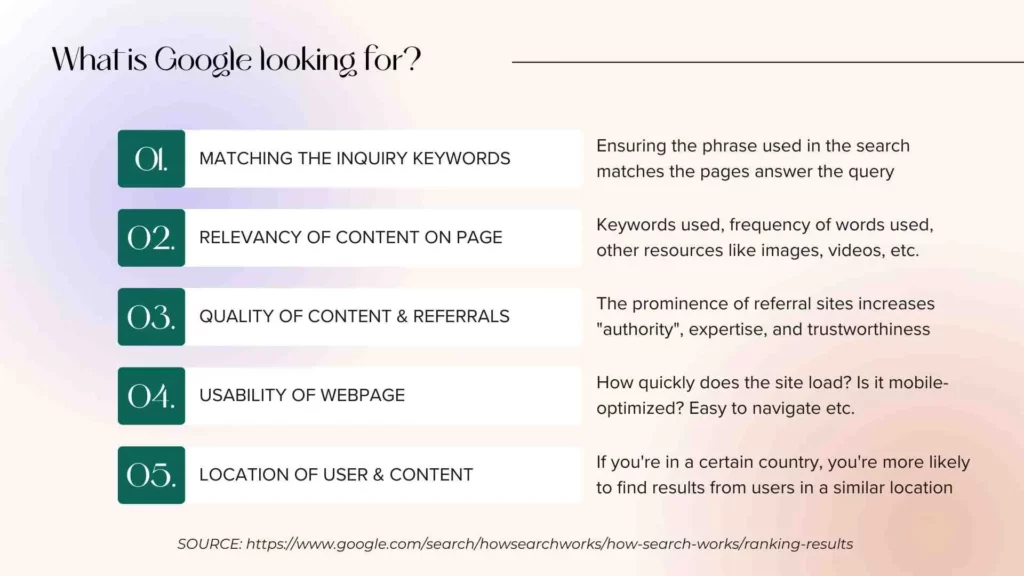
Finding the right keywords doesn’t have to be complicated—there are plenty of great (and free) tools to help you out! Here’s a mix of free and paid options to consider:
-
Google Autocomplete – A super simple trick: start typing a keyword into Google, and it will suggest commonly searched phrases. This is a great way to discover real-world search terms your potential clients are using. Another great source of keyword inspiration is the “People Also Ask” section on Google’s search results page. These FAQs highlight common questions that users search for, giving you insight into relevant topics to target in your content.
-
Google Keyword Planner – One of the best free keyword research tools. It helps you find high-volume search terms, see competition levels, and uncover keyword trends. A must-use for any SEO strategy.
-
Ahrefs Keyword Generator – This tool is a powerhouse for keyword research. The free version gives you a sneak peek into search trends and keyword difficulty, while the paid version unlocks more advanced insights like competitor keyword rankings.
-
Ubersuggest – A great beginner-friendly tool offering keyword ideas, search volume data, and competition analysis. It has both free and paid versions, making it an affordable alternative to more expensive SEO tools.
-
AnswerThePublic – This tool is perfect for content ideas. It shows the most common questions people ask about a topic, which can help you create blog posts that directly address potential clients’ concerns.
By using a combination of these tools, you can build a strong keyword strategy, improve your search rankings, and ultimately attract more clients to your therapy practice.
Understanding Search Engine Results
The Google SERP is the first page of google search results that always has 10 organic results and 4 potential paid spots for content to rank on.
The SERP Structure is as follows:
-
First four spots are always reserved for paid positions and sold to users who want to pay to rank for a specific keyword
-
The next 10 results are all organic results ranked in order of relevancy and authority
The most valuable place to be is in the top three spots of the FIRST page.
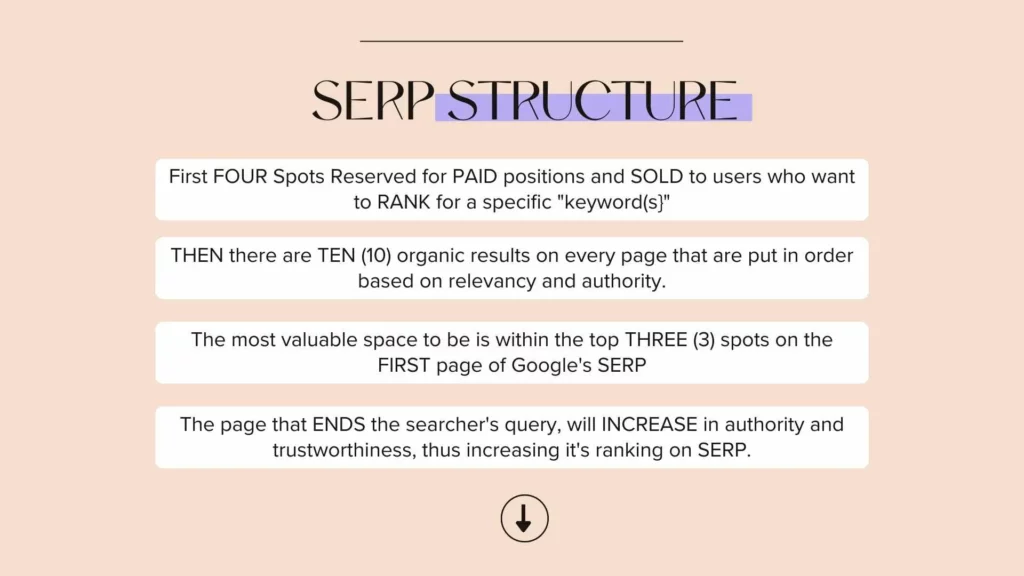
When you understand the power on page seo for therapists or any other private practice, you can see how ranking on Google can help drive new clients to your therapy services.
Below is an example of my business partner ranking #1 on Google for Brand & Web Design Packages and Google Analytics showcasing her page getting over 26% of all clicks (3,994) each MONTH from this single search term.
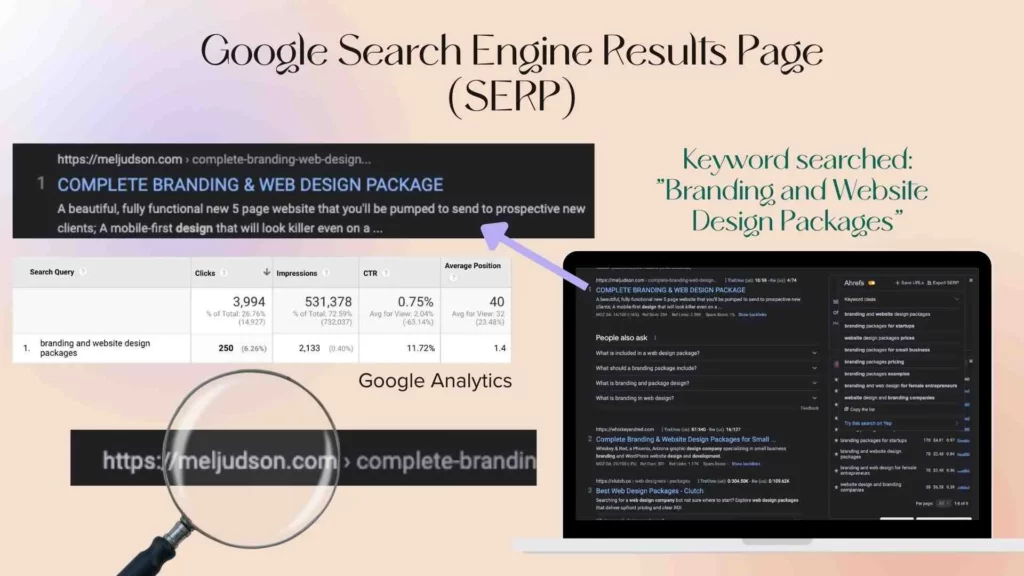
How To Perform Keyword Research
If you’re wanting to get the most out of your SEO efforts, we have to start with an optimal Keyword research process that allows us to see Google Trends for the Google Search Engine Results Page so we can see what kind of content is ranking and find keywords that we want to use within our own content.
How To Find Keywords You Can Rank For
Part of your content marketing strategy is knowing what keywords you need and how to pick the right keywords with the right search volume, Website traffic potential, keyword difficulty and cost per click (CPC) to build your content marketing plan with.
KPIS for Keyword Research
There are four main categories that you are looking at when doing your keyword research:
SEARCH VOLUME
The number of searches per month is based on an annual average and is country specific.
-
Essentially, Google’s algorithm measures how many times people are actively searching for specific keywords every day, week, month and year then comes up with an average monthly volume based on the previous years searches.
-
These numbers are specific to each country and may vary depending on whether you’re searching in the USA, Germany, Ireland, or Australia.
-
You want to add keywords that have medium to low search volume as your main target keywords that you know a potential client is searching for.
-
Keywords that have high search volume tend to be more difficult to rank for.
TRAFFIC POTENTIAL
This is how much traffic you can expect if your own site is ranking on the Google SERP or on the first page of other Search Engines.
It’s measured by taking the average of the top ranking pages search traffic for ALL keyword variations on each page that it ranks for.
-
You’re looking to add keywords that have a medium to high traffic potential for keywords that are easier to rank for.
KEYWORD DIFFICULTY
This is based on the total number of unique websites linking to the top 10 ranking pages on the SERP of Google and lets you know how hard it will be to rank on the top 10 for that specific keyword based on the number of backlinks you’ll need.
-
If you’re just getting started, you want to choose keywords with a low keyword difficulty ideally under 20-30 so you have a higher probability of ranking for those keywords.
COST PER CLICK ~
This measures how much advertisers are willing to pay for a click on an ad displayed on top of search results for any given keyword and is a great indicator of how valuable that keyword is.
-
The lower the cost per click, the easier it tends to be to rank for certain keywords but it’s also important to look at all factors for ranking.

Creating Keyword-Rich Content
Want to get the most out of your online presence? It’s not just about blog posts anymore. Mixing up your content with videos, FAQs, location-specific pages, and downloadable guides keeps things interesting and helps more people find you. Plus, search engines love variety!
Tips for Writing Engaging and Informative Content
-
Answer real questions: Think about what your audience is actually searching for and create content that gives them real, useful answers.
-
Mix it up: Blog posts are great, but also try videos to explain therapy techniques, FAQs to answer common concerns, and location-based pages to help local clients find you.
-
Give away helpful resources: A free e-book or guide on mental health topics can build trust and show potential clients what you offer.
-
Tell stories: Real-life examples and relatable experiences make your content more engaging and personal.
-
Keep it easy to read: Use headings, bullet points, and short paragraphs to make your content visually appealing and simple to digest.
Creating Content That Matches Search Intent
People search for information with a purpose, and your content should match that. Use keywords naturally in your titles, headers, and throughout your text, but focus on answering the deeper questions your audience is asking. When you provide valuable, well-organized content, search engines take notice and reward you with better rankings.
How to Show EEAT in Your Content
EEAT stands for Expertise, Experience, Authoritativeness, and Trustworthiness. These are key factors that help search engines (and potential clients) see you as a credible source.
-
Expertise: Share your knowledge on therapy techniques and mental health topics in a way that’s easy to understand.
-
Experience: Use real-world examples to show how your expertise helps people in practical ways.
-
Authoritativeness: Link to trusted sources and feature guest posts from other professionals in your field.
-
Trustworthiness: Be transparent about your credentials and offer advice backed by research and best practices.
Smart Keyword Placement Without Overdoing It
You want to rank well in searches without making your content sound robotic. Here’s how:
-
Put your main keywords in titles, headers, and the first paragraph naturally.
-
Use variations of your keywords in subheadings and throughout the text to keep things relevant.
-
Aim for a keyword density of about 1-2%—that means one or two mentions per 100 words to keep things natural and readable.
-
Avoid keyword stuffing: Overusing keywords can make content feel unnatural and harm your SEO. Instead, focus on writing for humans first while ensuring search engines can still understand your topic.
Key Takeaway
Therapists can boost their SEO by diversifying content types, focusing on search intent, and showcasing EEAT principles. Keep your content engaging, informative, and keyword-friendly without overloading it, and you’ll attract the right audience while improving your search rankings.
Creating Keyword-Rich Content
Want to improve your SEO strategy? Crafting compelling title tags with targeted keywords, writing effective meta descriptions, and structuring your content using proper header tag hierarchy (H1, H2, H3) are essential steps toward boosting organic traffic and enhancing user experience.
Crafting Compelling Title Tags with Targeted Keywords
Title tags are crucial for both SEO and user experience. They help search engines understand your page’s content while also enticing users to click. Keep your title tags concise, incorporate primary and secondary keywords naturally, and make them engaging.
An example of an optimized therapist-focused title tag could be: “Couples Counseling Services | Relationship Therapy in [City Name]”
Writing Effective Meta Descriptions Containing Important Key Phrases
A well-crafted meta description can significantly influence whether users decide to visit your site. Keep it brief (around 150-160 characters), include primary and secondary keywords, provide a clear summary of the page, and incorporate a call-to-action (CTA).
An example of an effective meta description for therapists could be: “Discover how our couples counseling services can help you improve communication and strengthen your relationship. Schedule your first session today.”
Understanding Header Tag Hierarchy and Its SEO Significance
Header tags (H1, H2, H3, etc.) help structure your content in a way that’s easy for both users and search engines to understand. Search engines use headers to determine the main topics of your page, so using them correctly can improve your rankings.
-
H1 (Main Heading): This should be the primary title of the page and include the main keyword. Each page should have only one H1.
-
H2 (Subheadings): These divide your content into key sections. They should include variations of your primary keyword to reinforce relevance.
-
H3 (Sub-subheadings): These provide additional structure within H2 sections, making the content easier to scan and digest.
Proper header usage not only improves readability but also boosts your SEO by signaling the importance of different sections to search engines.
Optimizing Image Alt Tags for Better SEO
Alt tags (alternative text) describe the content of an image for search engines and visually impaired users. Optimizing alt tags improves accessibility and boosts SEO by helping search engines understand image relevance to the page content.
-
Be descriptive: Clearly describe the image in a natural way.
-
Use keywords appropriately: Incorporate relevant keywords without keyword stuffing.
-
Keep it concise: Aim for a short, informative description.
For example, instead of “therapy session”, a better alt tag would be “Couples counseling session for improving communication skills”.
Implementing Schema Markup for Therapists
Don’t forget to implement schema markup on your website. Schema is a kind of data structure that aids search engines in comprehending the material on your web page.
By adding schema markup specifically designed for therapy-related businesses (PsychologicalTreatment), you can further enhance your online presence and increase visibility in search engine results pages (SERPs).
In summary, optimizing title tags, meta descriptions, header tags, and image alt tags is crucial for a strong SEO strategy. By structuring your content effectively and using targeted keywords in key areas, you can boost organic traffic and create a seamless user experience for visitors to your website.
Building Quality Backlinks for therapists
Backlinks from reputable sources can significantly impact your website’s authority, leading to improved rankings on Google.
For therapists, obtaining backlinks from directories specifically designed for mental health professionals as well as authoritative websites in the field is crucial and one of the easiest ways to improve the SEO on your private practice website.
In this section, we will discuss strategies for acquiring backlinks through outreach efforts and utilizing therapist directories effectively to increase traffic for your private practice.
Acquiring Backlinks Through Outreach Efforts
-
Create valuable content: Produce high-quality articles or resources that address common issues faced by individuals seeking therapy to increase the likelihood of other websites linking to your content organically.
-
Gather guest post opportunities: Reach out to relevant blogs and publications within the mental health industry and offer to write a guest post with a link back to your site. Make sure these sites have good domain authority before reaching out; tools like Moz Link Explorer can help you determine this information.
-
Promote on social media: Share your content on social media platforms such as LinkedIn or Facebook groups related to therapy and counseling.
This increases visibility while potentially attracting shares or links from others in the community. -
Collaborate with influencers: Partner with mental health influencers who may be interested in sharing or linking to your content based on its value-addition potential for their audience members.
Utilizing Therapist Directories Effectively
Besides outreach efforts, another way of building quality backlinks is by listing yourself on therapist-specific directories.
These platforms not only provide an opportunity for potential clients searching online but also serve as credible sources when it comes down to link building.
Here are some steps to follow when utilizing therapist directories:
- Research relevant directories: Look for reputable online directories that cater specifically to therapists, counselors, and mental health professionals. Some examples include Psychology Today, GoodTherapy, and the Psych Central Therapist Directory.
- Create a comprehensive profile: Ensure your profile is complete with accurate information about your practice, services offered, contact details, and any other pertinent data.
- Add a backlink to your website: Most therapist directories allow you to include a link back to your site within the profile section. Make sure this link is added correctly so viewers can easily navigate from the directory listing directly onto your website.
- Maintain an active presence: Regularly update your listings with new content or resources if possible; this will help keep them fresh while also demonstrating expertise in the field of therapy.
Building quality backlinks is essential for therapists looking to improve their website’s authority and search engine rankings while also generating clients for their private practice.
By utilizing the tactics discussed, you can boost your likelihood of getting backlinks from reliable sources and ultimately draw more ideal clients and potential customers to your business.
Technical SEO for Therapists: Building a Strong Website Foundation
Having great content and the right keywords isn’t enough—technical SEO ensures that search engines can properly crawl, index, and understand your therapy website. By optimizing your site’s structure and backend settings, you improve both rankings and user experience. Here’s what you need to know:
Site Architecture and Navigation
A well-organized website makes it easier for visitors (and search engines) to find important pages. Keep your navigation simple, logical, and user-friendly. Your homepage should link to key pages like your services, about, and contact pages, and each of those should be easy to access within just a few clicks.
XML Sitemap and Robots.txt
Your XML sitemap acts as a roadmap for search engines, helping them understand which pages to crawl and index. Make sure your sitemap is updated regularly and submitted to Google Search Console. Meanwhile, the robots.txt Tester helps ensure you’re not accidentally blocking important pages.
Secure Your Site with HTTPS
Security matters for both SEO and client trust. Make sure your site runs on HTTPS, which encrypts data and protects sensitive information. Most website platforms and hosting providers offer free SSL certificates, so there’s no excuse not to have it! You can check if your site is secure using a SSL checker.
Make Sure It’s Mobile-Friendly and Optimised for Page Speed
Most people will visit your site on their phones, so a mobile-friendly, fast-loading site is essential. You can test your site’s speed with Google PageSpeed Insights. Here’s how you can optimise it:
-
Optimise images: Compress and resize images to reduce file size without sacrificing quality. Converting images to WebP format can make pages load even faster. A free tool like Squoosh is great for image compression.
-
Minify code: Clean up your HTML, CSS, and JavaScript files by removing unnecessary characters, which speeds up page rendering.
-
Leverage browser caching: Store static elements of your site on visitors’ devices, so pages load faster when they return.
-
Avoid excessive plugins or scripts: Too many add-ons can slow down your site. Only use essential plugins to keep things running smoothly.
-
Create a mobile-friendly design: Your site should adjust seamlessly to different screen sizes, ensuring an optimal experience on any device.
Fix Broken Links and Redirects
Broken links frustrate visitors and hurt SEO. Regularly check for broken links and either fix or redirect them to relevant pages. If you’ve changed URLs, use 301 redirects to send users and search engines to the right place instead of leaving them with an error page. Free tools like Screaming Frog or SEMrush’s free website audit can help you find and fix broken links efficiently.
Optimize URL Structure
Your URLs should be clean, simple, and descriptive. Instead of long, complicated URLs with random numbers, use short, keyword-friendly URLs like:
✅ www.yoursite.com/anxiety-therapy
❌ www.yoursite.com/page?id=1234
Structured Data for Therapists
Adding structured data (Schema Markup) helps search engines understand your content better. For therapists, implementing PsychologicalTreatment schema can enhance your visibility in search results and improve how your practice appears in rich snippets. You can generate schema markup with Schema Markup Generator.
Key Takeaway
Technical SEO lays the groundwork for a well-optimized website that both search engines and clients can easily navigate. By improving site structure, security, speed, and crawlability, you increase your chances of ranking higher and providing a seamless experience for visitors.
Technical SEO doesn’t have to be complicated. By making a few simple tweaks, you can improve your site’s visibility and bring in more clients.
Optimize Your Own Website SEO for Therapists
You don’t need to be an expert SEO strategist to rank your therapy website or private practice website.
Just by understanding the basics on on page SEO, Keyword Research, and link building will help your private practice be better indexed by Google.
Here are some easy ways to improve your website’s SEO:
-
Find the right keywords. Think about what your ideal clients are searching for and use those keywords naturally on your homepage, about page, and services page.
-
Write strong title tags and meta descriptions. These are the first things people see in search results, so make them clear, engaging, and keyword-friendly.
-
Use headers to structure your content. Properly using H1, H2, and H3 tags makes your content easier to read and helps search engines understand it.
-
Link your pages together. Internal links help people (and search engines) navigate your site more smoothly.
-
Create helpful, engaging content. Blog posts, FAQs, and guides that answer common mental health questions can boost your credibility and attract more visitors.
-
Add alt text to images. Descriptive image alt tags improve accessibility and help search engines understand your content.
-
Get quality backlinks. Having other reputable sites link to yours (like directories or guest blogs) helps build trust and improve rankings.
-
Make your site fast and mobile-friendly. A slow website can hurt your rankings and drive visitors away. Simply reducing the file size of images and using the WebP format can make a big difference in speed.
A few small changes can make a big impact on how your site ranks—and how many people find and connect with your services.
Check out our full blog for creating an SEO Friendly website here.
Local SEO for Therapists: Get Found by Clients in Your Area
If you’re a therapist, local SEO is one of the most effective ways to connect with potential clients in your community. It’s all about making sure your practice shows up when people search for therapy services near them. Let’s go over some practical strategies to help you stand out in local search results.
Use Local Keywords Naturally
One of the simplest ways to boost your local SEO is by adding location-based keywords to your website. Include your city, neighbourhood, or even nearby landmarks in your content. For example, instead of just saying “anxiety therapy,” try “anxiety therapy in San Diego.” Just be sure to use these keywords naturally—stuffing them everywhere can hurt your rankings.
Optimize Your Google Business Profile
Your Google Business Profile (formerly Google My Business) is a must-have. It’s what helps your practice show up on Google Maps and local searches. Make sure your listing is complete with your correct name, address, phone number, website link, business hours, and high-quality images. The more detailed and updated your profile, the better your chances of appearing in front of local clients.
Get Listed in Online Directories
Being listed in reputable therapy directories increases your online presence and credibility. Platforms like Psychology Today, GoodTherapy, Bing Places, Yelp, Apple Maps, and Yellow Pages can all help clients find you. Make sure your Name, Address, and Phone Number (NAP) are consistent across all listings—this helps search engines trust your information.
Create Localized Content
Writing about topics relevant to your local community can help attract clients and improve your SEO. For instance, a blog post like “Coping with Stress in San Diego: Local Resources and Tips” can make your site more relevant to local searches. Consider discussing mental health trends in your area or sharing resources specific to your city.
Encourage Client Reviews
Online reviews play a big role in how Google ranks businesses. Ask satisfied clients to leave a review on Google, Yelp, or Facebook. Positive reviews not only improve your rankings but also build trust with potential clients.
Optimize for Voice Search
More people are using voice search to find local services. Optimize for this by using conversational phrases in your content, such as “Where can I find a therapist near me?” or “Who offers trauma therapy in San Diego?” Long-tail keywords and natural language help voice assistants understand your services better.
Get Involved in Local Events
Participating in or sponsoring local events can increase your visibility and earn backlinks from community websites. Consider speaking at local mental health workshops, partnering with nearby businesses, or getting featured in local news articles.
Stay Consistent and Keep Monitoring
SEO isn’t a one-time task—it requires regular updates and monitoring. Check your Google Business Profile, directory listings, and website content regularly to ensure everything stays accurate. The more consistent your information, the better your chances of ranking higher in local search results.
By implementing these local SEO strategies, you can make it easier for potential clients to find your practice and feel confident in reaching out for support.
Key Metrics to Track for SEO Success
Want to know if your SEO efforts are actually working? Tracking the right metrics makes all the difference. Here are some key ones to keep an eye on and the tools to track them:
-
Organic Traffic: This is the number of people finding your site through search engines. Track it using Google Analytics 4 (GA4) to see traffic trends and user behavior.
-
Keyword Rankings: See where your website lands in search results for therapy-related keywords. Ahrefs, SEMrush, or Moz can help you monitor ranking changes.
-
Click-Through Rate (CTR): How often do people click on your site after seeing it in search results? Google Search Console (GSC) provides CTR data so you can optimize your titles and meta descriptions.
-
Bounce Rate: If visitors leave your site quickly without interacting, they may not be finding what they need. GA4 helps analyze bounce rates and user engagement.
-
Conversion Rate: Are visitors booking appointments or reaching out? Track this in GA4 to see how well your site turns visitors into clients.
-
Backlink Profile: The more quality websites linking to yours, the better. Use Ahrefs or SEMrush to monitor backlinks and identify new link-building opportunities.
-
Page Load Speed: Slow websites can frustrate visitors and hurt rankings. Google PageSpeed Insights and GTmetrix can help you analyze and improve site speed.
Analyzing Competitor Performance
Keeping an eye on your competition can give you valuable insights. Tools like Google Search Console, SEMrush, Ahrefs, or Moz can help you see what’s working for them. Here’s what to look at:
-
Keyword Strategy: What keywords are they ranking for that you aren’t? Look for gaps you can take advantage of.
-
Backlink Profile: Who’s linking to them? You might find new opportunities to get high-quality backlinks.
-
Content Performance: Check out their top-performing blog posts and pages—what makes them successful? You can use this info to improve your own content.
-
Site Structure and UX: If their website is easy to navigate and user-friendly, take notes on what they’re doing right.
Staying Updated with SEO Trends
SEO changes all the time, so staying in the loop is crucial. Google frequently updates its algorithm, which can affect your rankings overnight. Keep up by following trusted sources like Google Search Central, Moz, Search Engine Journal, and Ahrefs. Adapting to new trends and best practices ensures your website stays visible and competitive.
By tracking these metrics, analyzing competitors, and staying informed, you’ll keep your therapy practice’s website in top shape—and keep attracting new clients!
Conclusion
SEO is an ongoing journey, and staying visible online means adapting to changes. This guide has covered everything from keyword research to technical optimizations—helping you attract more clients and grow your practice.
Here’s a quick recap:
-
Smart Keywords: Use long-tail, local, and low-competition keywords to match client searches.
-
Engaging Content: Blogs, videos, and FAQs build trust and improve rankings.
-
Technical SEO: Fast, mobile-friendly, and secure sites perform better.
-
Local Reach: Optimise your Google Business Profile and therapist directories.
-
Quality Backlinks: Build credibility through partnerships and guest posts.
-
Tracking & Adapting: Use analytics to refine your strategy.
SEO isn’t just about rankings—it’s about connecting with the right clients. Consistently applying these tactics can establish you as a trusted authority and increase your private practice’s visibility. Need expert help? SassandSEO can optimize your strategy and grow your practice. Let’s get started today!
Are you a Coach looking for how you can best apply this information to your industry?
Check out the full SEO Marketing For Coaches blog here to learn how to use SEO for automating your lead generation or check out our Free SEO for Therapists, Coaches & Mental Health Services Workshop here.
We also have a SEO For Coaches A Complete guide for beginners in 2025 linked here.
Frequently Asked Questions (FAQs) about SEO for Therapists
1. How to do SEO as a therapist?
To optimize your therapist website for search engines, focus on relevant keywords, keyword-rich content, title tags, meta descriptions, backlinks, site performance, and Google Business listings. Use tools like SEMrush or GTMetrix to analyze your website’s performance.
Our full guide walks you through SEO for beginners and the exact steps from zero to ranking that you can read by clicking the link here.
This Guide will walk you through the foundations of Search Engine Optimization, how to find the right keywords to create content, and how to leverage your awareness of mental health issues or other topics of expertise in your chosen industry to write quality content that ranks.
2. What is SEO in therapy?
SEO in therapy means optimizing a therapist’s website for search engines by using strategies like keyword research, content creation, and best practices to attract new clients by knowing how to create content that answers the general questions your ideal clients are searching for on Google.
3. What are the top 5 strategies for SEO for therapists?
-
Keyword research
-
High-quality content creation
-
Title tag & meta description optimization
-
Backlink building
-
Site performance analysis
4. What are the best strategies for SEO for therapists?
-
Focus on user intent when researching keywords
-
Publish informative & valuable content consistently
-
Maintain mobile-friendly web design
-
Build business listings & citations
-
Utilize schema markup to enhance search engine understanding of your content
SEO Services for Therapists & Other Mental Health Services
We offer SEO services including keyword research, link building, on page SEO, blogging, pinterest management and more through our Online Business Automator Agency.
If you’re looking for a way to improve organic traffic to your private practice without having to learn all the technical SEO, our team will create a custom SEO for therapists strategy with the option to have our team take over the on page SEO and link building process for you or you can take the strategy and implement it yourself.
To learn more about our SEO services, click here.
Download our Free Guide: 3 Steps To Build Your Business Beyond The Feed in 2025

This Free Guide covers the importance of web design, content creation, and the optimal minimal viable funnel to start ranking on Google and automating lead generation so you can get clients through Google.

